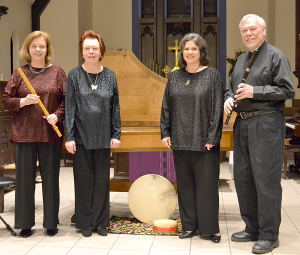The second concert of the 2016 season of the Swannanoa Chamber Music Festival featured the Enso String Quartet. This first performance was held at the Kittredge Theatre, Warren Wilson College, while repeat concerts will be in Waynesville NC and Greenville SC.
The Enso String Quartet was formed at Yale University in 1999, the same year that Boson Mo, age seven, began playing violin. This summer, 26-year-old Mo is filling in as first violin of the quartet. They could do much worse than offering this talented Canadian the position on a permanent basis when he completes his doctorate at Rice University. Or sooner. A few years ago, violinist John Marcus left the Enso and was replaced by Ken Hamao. Now violinist Maureen Nelson has accepted a position with the St. Paul Chamber Orchestra, and only the low strings (Melissa Reardon on viola and Richard Belcher on cello) are familiar faces from the past. But that happens as quartets age; there are departures and the remaining members seek replacements. Continuity is achieved through a careful selection of new members appropriate to the quartet’s artistic vision.
And there is no doubt that this quartet, from its inception, has had its own vision. Among other things, they have explored little-known repertoire from composers whose fame was gained in opera, not chamber music. An exquisite find for them was Giacomo Puccini’s “Crisantemi” (“Chrysanthemums”), a short elegy composed in 1890 upon the death of the Duke of Savoy. While an arrangement for string orchestra was known, the original work for string quartet had fallen into oblivion, and was revived by the Enso. This work opened the program with its two dark themes (later reused by Puccini in Manon Lescaut). On stage was a painting by Russian émigré Andrey Tamarchenko that was inspired by the music, a contemporary oil painting that will be auctioned for the benefit of the Swannanoa Chamber Music Festival.
Gabriel Fauré’s Piano Quartet No. 1 in C minor, Op. 15, completed the first half of the program. Pianist (and festival artistic director) Inessa Zaretsky joined Hamao, Reardon and Belcher for this work, while Mo turned pages of the piano score. (And don’t underrate the importance of a skilled page-turner!) The Scherzo was a little rushed for my taste. I would have liked to feel more clarity in the exposition rather than simple virtuosity, which the performers provided in good measure. The final movement, an Allegro Molto, was upbeat and fully satisfying. This movement’s tonal ambiguities are the sort of thing that causes musicologists to suggest that Fauré was anticipating modern atonality.
I am always happy when a collaborative pianist leaves a Steinway D fully open. This gives us the full tonal presence of the instrument, while depending upon the pianist’s skill to moderate the volume in order not to overpower the strings. The other school of thought is to leave the piano lid half-open on the short stick, which makes the dynamic match easier but reduces the tonal color. Particularly for Fauré and later works, Zaretsky’s choice of the long stick was correct in my view.
Following intermission, the Fourth of July weekend was celebrated with the performance of Antonín Dvořák’s String Quartet in F, Op. 96, known as the “American Quartet.” This ebullient work relies more heavily upon Bohemian folk music (particularly in the third and fourth movements) than it does on characteristically American themes, but I will concede that in the Lento, Dvořák gives us his take on Native American and African-American music. Regardless of where the source material came from, it was put together, and quite rapidly, one summer in Spillville, Iowa and so is “Middle American” in that regard (although Spillville was a community of predominantly Czech immigrants among whom Dvořák was at ease). It was during this performance that I became convinced of Mo’s quality. The delicacy with which he played the second theme of the Allegro ma non troppo, his collaboration with viola and cello in the Lento, and the mutual joy of the Finale demonstrated a musician with a temperament that invites collaboration.
Only after the concert did it occur to me that all three works were completed in the short space between 1883 and 1893. Three composers, all pointing the way to the future, and probably puzzling nineteenth-century listeners with their innovations. To schedule these three pieces was skillful programming.
The upcoming performances at the Swannanoa Chamber Music Festival are listed on their website and in our calendar.












